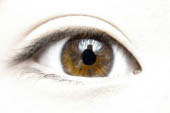
Purpose
To demonstrate that a region of no visual sensitivity known as the ‘Blind Spot’ does exist on the retina of the human eye
Additional information
The eye’s retina (light-sensitive lining inside the eye) receives and reacts to incoming light and sends appropriate signals to the brain; this is the process that facilitates vision. There is, however, a portion of the retina that does not respond to visual stimuli known as the eye’s blind spot.
Sponsored Links
Required materials
- One 3 x 5 inch (8 x 13 cm) card or stiff paper
- Marker
- A meter-stick
Estimated Experiment Time
Less than 5 minutes
Step-By-Step Procedure
- 1. Mark a dot and a cross on a card.
- 2. Hold the card ensuring that the cross is on your right, at eye level about an arm’s length away. You may use the meter-stick to support your arm while moving the card back and forth.
- 3. Scenario 1: Close your right eye and look directly at the cross with your left eye. Notice that you can also see the dot.
- 4. Focus on the cross as you slowly bring the card toward your face. Also be aware of the dot.
- 5. Scenario 2: Repeat the same procedure with your right eye – close your left eye and look directly at the dot. What happens to the cross?
Note
As a variation on this activity, draw a straight line across the card through the center of the cross and the dot. When the dot disappears, the line appears to be continuous without a gap where the dot actually is. The brain automatically ‘fills in’ the blind spot with a simple extension of the image immediately surrounding the blind spot. This is why the blind spot does not affect day-to-day visual observations.
Observation
In scenario 1, as you slowly bring the card toward your face the dot will disappear, and then reappear. Similarly in scenario 2 the cross will disappear and reappear as you bring the card slowly toward your face.
Result
The optic nerve carries impulses from visual stimuli received by your eye to your brain. This bundle of nerve fibers passes through one spot on the retina of your eye where there are no light receptors. It is when the card reaches the exact point where the light from the dot or cross falls on this spot that you cannot see it.
Sponsored Links
Take a moment to visit our table of Periodic Elements page where you can get an in-depth view of all the elements,
complete with the industry first side-by-side element comparisons!